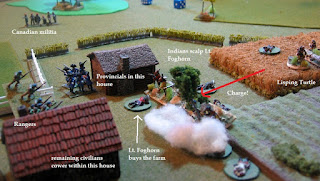We played a couple games of Muskets and Mohawks last night. Both
games were 200 points per side played with our 15mm figures mounted 3 infantry
per base. The first game saw me lead the reserve squad of British regulars
while Bill was Lt. Foghorn, with a squad of Provincials and a team of Rangers.
The British were tasked with defending the homes of the locals at the hamlet of
Sticky Bottom.
The perfidious French & Indians were led by Rick as
Chief Lisping Turtle with two teams of warriors and Jay leading a squad of
backwoods Canadian militia. They were on an evil mission: slaughter the
settlers of Sticky Bottom! Boo, hiss!
The Indians moved with incredible speed while the Civilian
card didn’t come up in a timely fashion. This had unfortunate consequences, as
seen below.
The photo below is mislabeled. The staff will have to be
flogged. The bodies are those of Canadian militia. The Canadians fell back,
then in time came forward and fired.
You will note that my 15mm houses do not have lift-off
roofs. Oh well. Lisping Turtle urged his warriors forward on the En
Avant/Forward Boys card, judiciously staying behind. Two tomahawks flew towards
Lt. Foghorn. One bounced off his gorget! The other, unfortunately, cleft his
skull. The Indians stopped around his corpse and had themselves a scalping
party, also lifting the gorget. The regulars arrived on table.
The Rangers charged and were driven back by these Indians.
The other team of warriors charged the lower house and cut their way in after
stiff resistance by the civilians, whose survivors fled out the window. But the
regular card came up and a wild bayonet and tomahawk fight ensued, with heavy
losses on both sides. When it was over all of the warriors had been slain and
the regulars held the house.
The Rangers now fired a deadly close range volley and
brought down most warriors of the other team, the few survivors heading for the
hills. Chief Lisping Turtle called it a day. Both sides had lost 50% of their
starting forces. The Indians failed to wipe out the civilians and so didn’t
make their victory conditions. The British didn’t protect half of their
civilian charges – though at this moment I realize their victory conditions for
this scenario were to protect the houses, so they might indeed have attained
their victory conditions. This is the first time we have played these rules and
of course we made some mistakes. Mainly, though, all enjoyed the game. Losses
were some 12 French and Indians, and some 15 British and civilians. It had
taken about 90 minutes so we switched sides.
I was Chief Running Dog and Bill led the Canadian militia,
looking to scout the hamlet of Sticky Bottom. Rick and Jay were ordered to
protect the settlers. In keeping with our less sanguinary motives, we opted for
a game of feint and movement.
I moved all my warriors to the edge of a copse and traded
fire with the Provincials. Their fire was too hot for us. One team of warriors
recoiled and the other fell back, considering that sector of the table scouted.
I began moving to the British right. The Rangers side stepped to
parry that. The Canadians advanced into the gap to scout that sector but were
unable to pull back again before the British turned and fired on them with effect.
Meanwhile the civilians had run into the houses, covered by a shield of
Provincials. The regulars now appeared and marched in a column past the wheat field.
Running Dog and a team of warriors advanced against their rear at close range. Both
sides waited to see if an Indian or regular card came up first; none did for a while.
By the time an Indian card came up I had thought better of firing into the
fresh regulars and instead took off. We fled the table, having made our victory
conditions: scouting each sector of the table and having at least 1/3 of our troops
left. But the British had made theirs also: at least half (in fact all) of
their civilians safe. Sticky Bottom would continue to beckon to other settlers. We lost 3
Indians and 5 Canadians while British losses were 2 Rangers and 2 Provincials.
This game took a little over an hour. Again, much fun was had by all. We are
thinking about having a 400 point per side game next time. And perhaps
remembering to roll dice for when the game ends… I don’t think we’re up to
speed enough to have side plots yet. In this game the Indians
feel very different than the regulars - a good thing.
















































